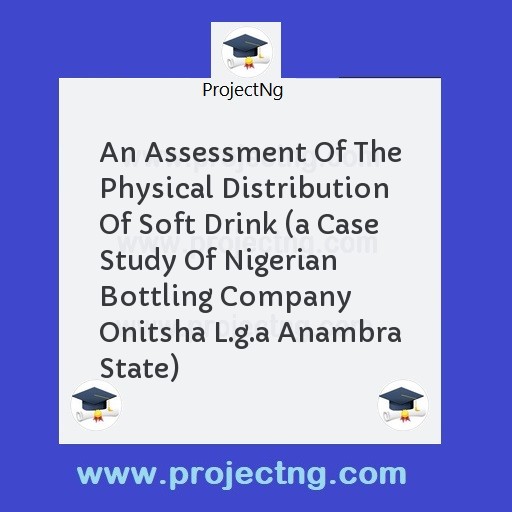An Assessment Of The Physical Distribution Of Soft Drink (a Case Study Of Nigerian Bottling Company Onitsha L.g.a Anambra State)
Marketing Project Topics
Get the Complete Project Materials Now! »
ABSTRACT
Distribution of soft drinks in Nigeria simply implies the system through which the soft drinks are brought to the prospect final consumer within the Nigeria economy. To carefully examine the attitude, feelings and reactions of consumers towards the physical distribution of soft drinks. And to examine the actual channels of physical distribution of soft drinks. This research work will be highly beneficial and appreciated in many ways or areas of educational and human developments, it would be beneficial to traders of soft drinks consumers and merchants who have one intensions of consuming soft drinks and industries, especially coca-cola, Onitsha. The physical distribution of soft drinks in Nigeria have improved the technical equipment and its usage, it encourages the economic growth of the Nigeria economy. The management of these soft drinks industries should constantly organized workshops, seminars and conferences for on public relationship and normal consumers approach.
CHAPTER ONE
INTRODUCTION
1.1 BACKGROUND OF THE STUDY
Distribution of soft drinks in Nigeria simply suplies the system through which the soft drinks are brought to the prospect final consumers within the Nigeria economy. Soft drinks are produced by the soft drinks industries within and outside the country and carefully distributed to the final consumers in order to complete the production processes. In the physical distributed to the final consumers in order to complete the production process. In the physical distribution of these soft drinks, basically, two various classified channels can be pinpoint or drawn, normal 3 – ways distribution channels (ie Manufacturers, Wholesales, Retailers - Consumers) and 2 – ways distribution channel (i.e. Manufacturers, Wholesales/Retailers – Consumer).
In the former, manufacturers of soft drinks carry their products in bulks of different brands to the deport owners (ie the wholesalers) and they in turn carry to the were shops or restaurants owners (ie the retailers) and these people sell directly to the final consumers in smaller quantities. While, in one latter, the manufacturers of the soft drinks, big hotels and restaurants where the final consumers buy or to the depots, where the final consumers can equally buy for big occasions.
There are many different soft drinks industries all over the world. Some concentrate on one brand of drink, while some operate on assorted brands in order to meet their customer/consumer targeted objectives.
Though, there are (3) principally recognized companies in the soft drinks production and distributions – (a) coca-cola company (b) Pepsi company and (c) Cadbury Schweppes.
Cadbury Schweppes recently emerged in 1995, when the acquires the Dr. Peper and 7up brands and began to competes with coca-cola and Pepsi.
Coca-cola Handling, Bottling Company produces, sells and distributes a broad range of beverage to meet the constantly changing tastes and needs of its consumers across 26 countries worldwide. Its products include;
a) Carbonated soft drinks – coca, fanta and sprite
b) Sugar – Free carbonated soft drinks – sprite zero, coca-cola light etc.
c) Juices, nectars and juices drinks – Cappy, 5-live, Amita, Friuce etc.
d) Ready – to – drink teas and coffees – Nestea and Nescafe. And any other numerous involve to mentioned.
These soft drinks productions involves mixing a number of ingredients including, water, sugar/ sweeteners, colouring agents, and carbon dioxide. Soft drinks are sold at formtains and some are equally sold as packaged in industry that 75% of all soft drinks sold in the U.S were in 4c packaged formed. There are certain substitute products of beverages in the market today worldwide such as; cold coffees, caffeinated and flavored water, carbonated flavored milk, fruit and vegetable juice blends, caffeinated orange juice etc. These soft drinks industries most seek official approval by the government regulative organs (National Agency for Food, Drug and Administrative Control, NAFDAC in Nigeria, Food and Drug Administration U.S.) before any of this products can be duly produced for consumption. Their inputs, raw materials must be tested and approved before their procession.
People’s preference and tastes for soft drinks continuously evolving and coca-cola company equally strives to offer an increasingly wide choice of beverages that meet those changing needs. growing categories to becomes a more diverse alcohol – free beverage company is a strategic priority for coca-cola company and in 2004, it produced and distributed more than 360 different beverage flavours and products, excluding packaging variation. In 2004, it distributed over 8,000 million liters of non-alcoholic brands, an increase of 40% over the previves year. (Annual Report, 2004) carbonated soft drinks still accounted for the largest proportion (77%) of sales volume in 2004.
However, water, juice and other non-carbonated beverages represented 23% of distribution up from 10% in 2001 and 19% in 2003.
In the physical distribution of coca-cola soft drink. In Onitsha, it has been adequately progressives. Many are have been receiving normal and constant supplied Odoakpu, Nkpor, Fegge, Awada, Omagbas etc.
Though, poor roads had been a hindrance to a certain degree in the efficient distributions of these soft drinks in Onisha metropolitans.
1.2 STATEMENT OF THE PROBLEMS
This project work is mainly designed to access the physical distribution of soft drinks in the Nigerian economy special focus on “coca-cola company, Onitsha South Local Government Area of Anambra State.
From numerous conducted research and it’s empirical view, many factors actually hindered the effective and efficient physical distribution of soft drinks. The below spelt out problems or factors will be dealt with by the research on the cause of this research project.
v Poor roads
v High transportation fares
v High regulative standards by government agencies
v Inadequate storing depot or warehouse.
v Constant involving consumers’ preference and tastes.
v Inadequate provision of infrastructural amenities.
v Short and failure in electricity supplies.
Be the First to Share On Social

Enjoying our content?
Don't miss out on new videos! Subscribe to our YouTube channel for more awesome content.
Subscribe Now!













